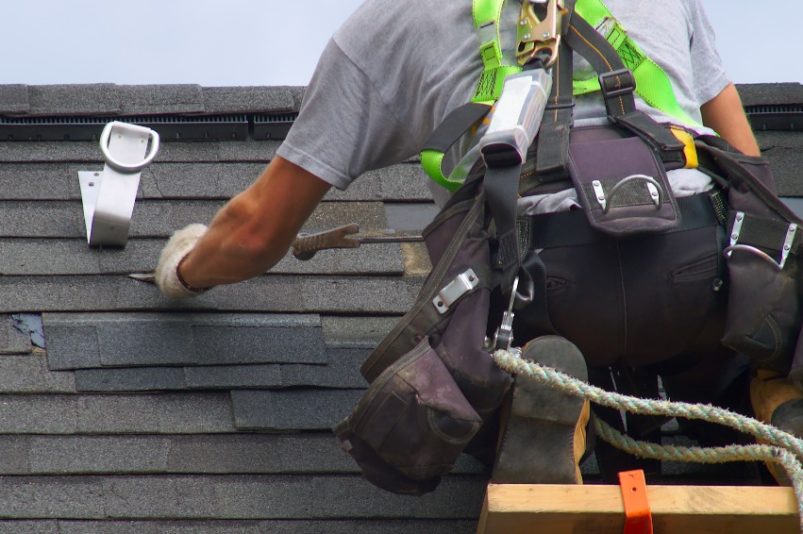
Navigating the peaks and valleys of your home’s roof may seem like a daunting task reserved only for experienced professionals. Indeed, walking on a roof can be perilous without the right knowledge and safety measures in place. This blog post aims to guide you through the vital steps and techniques for safely walking on a roof. Remember, while this guide will equip you with some basics, it’s important to understand that roof walking can be dangerous and should be done with extreme caution, if not left to professionals.
Safety Considerations
Your safety is paramount when walking on a roof. Therefore, before you even consider setting foot on those shingles, you need to be thoroughly prepared. Let’s walk through the key aspects of this preparation.
Before stepping onto the roof, ensure you’re wearing a well-fitted safety harness that’s secured to a stable structure. Also, consider using a safety rope and always have a spotter — a person who stays on the ground and is ready to call for help in case of an emergency. Never underestimate the importance of these safety measures; they could mean the difference between a minor misstep and a severe accident.
From a distance, inspect the roof’s condition. Look for any signs of damage or loose shingles that might make your footing unstable. If the roof appears to be in poor condition, it’s best not to walk on it. Also, take note of the roof’s slope. A steeper pitch will be more challenging to navigate and requires additional precautions.
Your choice of footwear can significantly impact your safety when walking on a roof. Specialized roofing boots, which feature slip-resistant soles, are designed for this task and can provide excellent traction, even on steeper slopes. Never wear footwear without proper traction.
Mother Nature can dramatically affect your roof-walking experience. If it has recently rained or snowed, the roof’s surface can be slippery, significantly increasing the risk of accidents. Likewise, high winds can make it hard to maintain balance. Always check the weather before deciding to venture onto a roof.
Understanding Roof Walking Techniques
After preparing properly, it’s time to make your ascent. The success of your roof-walking endeavor largely depends on your approach, particularly where and how you step. Always start at the edge of the roof. This provides a clear path and allows you to gradually acclimate to the slope and surface of the roof. Jumping into the middle can be disorienting and destabilizing, increasing the risk of slips and falls.
When taking your first steps, you should place your feet on the lower third part of the shingle. This is where the nails fasten it to the roof, providing the most secure point to step on. Random or careless step placement can lead to slipping or dislodging the shingles, causing damage to the roof and potential instability for you.
The techniques you employ for moving across the roof are paramount for maintaining balance and security. One method many professionals use is the “Duck Walk.” This involves bending your knees slightly and moving sideways, almost as if you were waddling. This strategy helps lower your center of gravity and distribute your weight more evenly across the roof surface, reducing the risk of losing balance. It’s important to take small, measured steps, as large strides can upset your balance and create a higher risk of slipping.
When it comes to descending from the roof, the same principles apply but with a twist: it’s safer to descend backward, similar to how you would come down a ladder. This strategy ensures your body weight is directed into the roof, offering better stability. Always move slowly and carefully during this process to minimize the risk of missteps.
For those moments when you need to move horizontally across the roof, opt for a diagonal path. This reduces the length of time you are walking directly across the slope, which can be a riskier movement. By incorporating a diagonal path, you are always somewhat aligned with the ridge of the roof, providing additional balance and stability.
Remember, every roof is different and may require adaptations of these techniques. Always prioritize safety and caution when adjusting these strategies to suit your specific circumstances.
FAQ
To round out this guide, let’s address some frequently asked questions about roof walking:
- Is it safe to walk on a wet roof? No, walking on a wet roof significantly increases the risk of slipping and falling. Always ensure the roof is dry before attempting to walk on it.
- What types of roofs are the most challenging to walk on? Steeply pitched roofs and roofs made of metal or tile can be particularly challenging and hazardous to navigate.
- What’s the best footwear for roof walking? Specialized roofing boots with slip-resistant soles are the best choice. They provide excellent traction to help prevent slips and falls.
- What do I do if I slip or lose my balance on the roof? This is where your safety harness and rope come into play. They should arrest your fall. However, if you find yourself frequently losing balance, it’s a sign you should probably hire a professional roofer.
- What are the consequences of damaging my roof by walking on it improperly? Walking improperly on your roof can cause significant damage, including broken shingles or tiles. This damage can lead to leaks and other issues, potentially costing you a lot in repairs.
Conclusion
Walking on a roof is not an activity to take lightly. It requires a proper understanding of the risks involved and the techniques to mitigate these risks. We hope this guide has given you an overview of what’s required, but remember: when in doubt, it’s always better to call in the professionals. They have the expertise to handle the job safely and effectively. And remember, your safety should always be your top priority.





